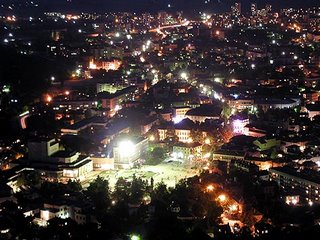Town as the montain - ancient and young!

Only 116 km away from Sofia, at an altitude of 370 m - the town of Vratza is one of the most picturesque cities in Bulgaria. Nestling in the foothills of "Vrachanska Planina", with the Leva river calmly crossing the town and with fearful rocks overhanging the roofs. Few Bulgarian cities have a history passing through thousands of years and several historical ages! Vratza is one of them.
Situated in the Balkan Mountain itself among nature blessed by the Lord and amazing with its beauty, "Vratza is a place created by the Spirit, where knowledge and art are flourishing so other areas of our country can use them too". This was written by "Tzarigradski Vestnik"(Tzarigrad`s newspaper) in 1858, in Tzarigrad-today`s city of Istanbul.
HISTORY
________________________________________
There are several views concerning the origin of the population in our lands in the Bronze and the Iron Age. The most plausible one, is that the Thracians, who were one of the most numerous Indoeuropean people in ancient times, inhabited the eastern part of the Balkan Peninsula. It it still uncertain who were the oldest Thracian tribes that inhabited the territory of nowadays Vratza and the adjoining districts since these tribes were constantly moving and fighting with each other. Some such articles were already recovered in the region of Vratza, among which a bronze axe dug up near the village of Zgorigrad and a bronze axe, found near the Leva River in 1970.
Several decades prior to the Ottoman invasion on the Balkan Peninsula, the Bulgarian state was divided into three “tzarstva”(kingdoms) that easily fell victim to the Ottomans. It is known that in the years following the division of the Bulgarian state the town of Vratisa was part of the Turnovo kingdom and stood on its border with the Vidin kingdom. The scanty evidence testifying to the struggles of the Vratisa people against the Ottoman oppressors is largely legendary. That makes it hard to a certain the exact year when the Ottomans tore down the town and subjected its population to a yoke that lasted almost five centuries. The deposition of a regular Turkish army in Vratsa coincided with the arrival of a report saying that a cheta (military detachment) was being formed in Rumania and it was to make its way to Vratza. Soon after that a letter came to Vratsa, written by the immigrants D.Todorov and M.Tsvetkov and it informed the conspirators that the cheta (band) was led by Hristo Botev and the town should rise in revolt on the day of its passing through. On 20 th May (1 st June, new style) 1876 the cheta reached the Vratsa mountains and engaged in battle with the numerous enemy. At nightfall the commanding staff held a meeting under the Kamarata Highs. Just when Hristo Botev rose to speak a shot came - the voivode, who was also a poet genius and a revolutionary, was mortally wounded. The days following 20 th May were days of celebration for the Turks. They drove around town the impaled heads of insurgents and members of Botev’s cheta.
LANDMARKS
________________________________________
The Ethnographic Revival Complex St.Sofronii Vrachanski is an interesting place that you can visit. The community centre 'Razvitie' (1869) and the Historical Museum keep the century - old history of the town. The “Holy Ascension” and “St. Nicholas”Churches are also of great interest.
SURROUNDING AREAS
________________________________________
Vratsa is a starting point for the routes to Vratsata gorge and Ledenika cave. The Nature Park Vrachanski Balkan, situated near town, offers great opportunities for on-foot tourism. Here is the richest cave region in the country.
Vratsata rock massif - an impressive vertical wall (more than 400m high) is a preferred place for rock climbing. Those of you who like adrenalin sports can parachute down from “Okolchitsa” hut.
The picturesque villages Pavolche, Chelopek and Zgorigrad will greet you with the hospitality of the village homes, the delicious traditional dishes and local wines. The wonderful nature and the fresh mountain air allow ecology camps with educational programmes for children to be organized.
The complex Ledenika is located at about 16 km. southwest of the town. It is settled near to the territory of Ledenika cave. There are about 20 rest houses in the region.
You must visit the place where Hristo Botev was killed, at Vola peak (24 km Southwest).
To see pictures of this wonderfull town and the surrounding area CLICK HERE http://romelland.myphotoalbum.com/view_album.php?set_albumName=album03
